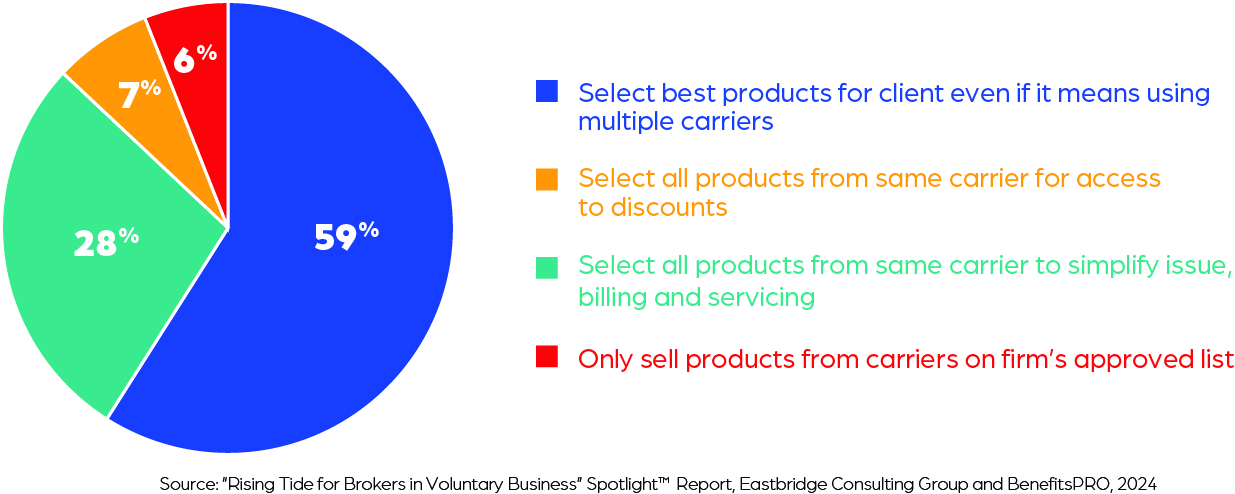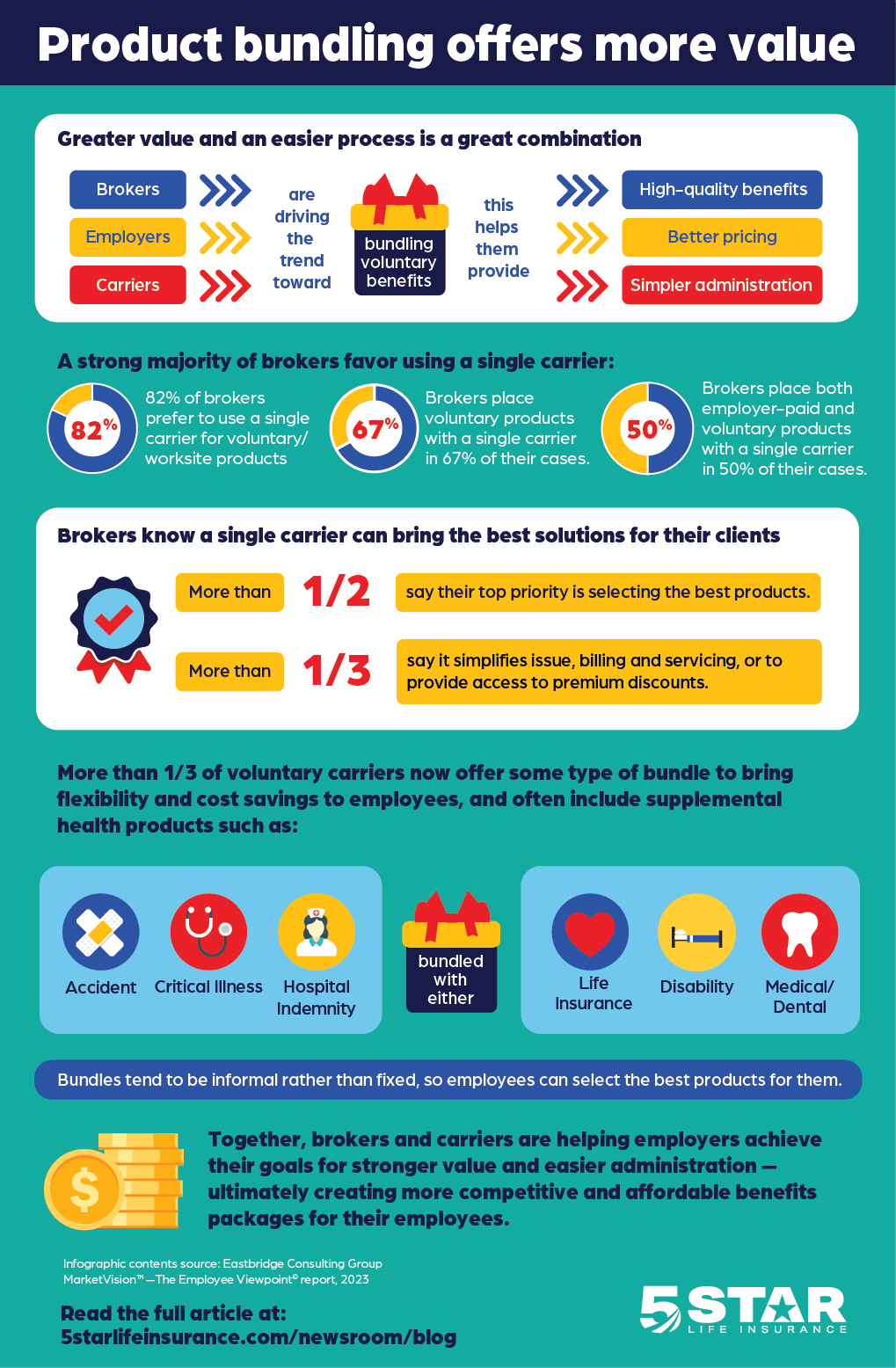Brokers use product bundling to offer clients more value
The best employee benefits package isn’t necessarily the one with the most bells and whistles. It’s the one the most employees sign up for — and the choice to participate often depends on a strong benefits education and enrollment support plan that empowers employees to make informed decisions.

Voluntary benefits complement and help fill the gaps in major medical coverage with benefits employees can use for copayments, deductibles or other out-of-pocket expenses when an accident or illness occurs. These unexpected costs can be sizeable, especially with the continuing trend toward high-deductible health plans. Brokers can help their clients incorporate voluntary benefits to design a comprehensive, affordable benefits plan that meets the unique needs of their workforce and attracts and retains top talent — but if employees don’t participate in it, the employer’s investment of valuable resources is wasted. That’s why any successful benefits package needs to involve more than products and rates. It also must focus on helping employees understand their options, see how the benefits available address their unique needs, and encourage them to actively participate in their benefits program. Brokers can help their clients leverage best-in-class technology and benefit communication strategies to drive stronger participation in their voluntary benefits.
Carriers offer flexibility and cost savings with product bundles
The number of carriers offering product bundles has grown significantly in the past four years. Eastbridge’s recent “Voluntary Product Trends” Frontline™ report shows more than a third of voluntary carriers now offer some type of bundle, most often supplemental health products such as accident, critical illness or hospital indemnity bundled with either core group disability and life products or medical and dental products.
Flexibility is a high priority for most carriers. These product bundles are more likely to be informal rather than fixed, so employees can select the products they want to purchase. Only one in five carriers that offer bundles present a set package where employees must make a yes or no election and can’t choose the components or coverage levels they need.
Carriers also understand the importance of helping employers create cost-effective benefits plans. Many carriers that bundle products offer premium discounts based on case demographics, risk and the types of products offered, such as medical plans, nonmedical employer-funded products or voluntary products. However, product quality and easier administration far outweigh price discounts for most brokers when choosing voluntary partners.
Product bundling meets employers’ top criteria for carrier selection
Product bundling can also play a role when employers select a voluntary carrier — but brokers may need to help connect the dots for their clients to see why. Recent Eastbridge research shows the top factors most important to employers when choosing a voluntary carrier are the price/value of the products offered and the ease of administration for billing and service. In addition, nearly two-thirds of employers say single billing for all voluntary products is an important or very important factor. These criteria all align precisely with the advantages of product bundling.

Packaging a better benefits plan
Brokers increasingly see the value in bundling voluntary products with one carrier to save their clients time and money through streamlined issue, billing and service, while carriers are meeting the demand for bundled products with flexibly designed packages. Together, brokers and carriers are helping employers achieve their goals for stronger value and easier administration — ultimately creating more competitive and affordable benefits packages for their employees. Voluntary product bundling appears to be both a growing trend and a winning strategy for all key stakeholders.
5Star Life Insurance Company is available to partner with brokers interested in helping their clients take advantage of the market’s trend toward product bundling. Learn more about us and our commitment to partnering with you and your clients by visiting us online.
The best employee benefits package isn’t necessarily the one with the most bells and whistles. It’s the one the most employees sign up for — and the choice to participate often depends on a strong benefits education and enrollment support plan that empowers employees to make informed decisions.

Voluntary benefits complement and help fill the gaps in major medical coverage with benefits employees can use for copayments, deductibles or other out-of-pocket expenses when an accident or illness occurs. These unexpected costs can be sizeable, especially with the continuing trend toward high-deductible health plans. Brokers can help their clients incorporate voluntary benefits to design a comprehensive, affordable benefits plan that meets the unique needs of their workforce and attracts and retains top talent — but if employees don’t participate in it, the employer’s investment of valuable resources is wasted. That’s why any successful benefits package needs to involve more than products and rates. It also must focus on helping employees understand their options, see how the benefits available address their unique needs, and encourage them to actively participate in their benefits program. Brokers can help their clients leverage best-in-class technology and benefit communication strategies to drive stronger participation in their voluntary benefits.
Communicate, communicate, communicate
Employees won’t sign up for benefits if they don’t understand where they might have gaps in their coverage, what benefits are available to them, and how those benefits can help protect them and their families — and nearly every plan has variations. That’s why effective benefits communication starts long before the planned enrollment period.
Brokers should consult with their clients to map out a communication and engagement plan starting at least one to two months before the enrollment. It’s important to use a variety of formats and methods to reach employees when and where they want: email, texts, website or intranet, print materials distributed at the office or mailed to employees’ homes, mobile apps, videos, and in-person or virtual meetings. The content should cover the benefits available, how they work and what they can provide. Claims scenarios that illustrate the value of the benefits and decision-support tools that guide employees in determining their coverage needs also are helpful.
Customized, personalized communications based on an employee’s life stage can help increase employees’ understanding and engagement. A young single, a married 30-something with children, and a mature employee nearing retirement have different needs and communication preferences. For example, research shows Baby Boomers are much more likely than workers in other generations to find printed materials sent to them at home or at work helpful for introducing voluntary benefits, while text messages appeal more to Generation Z employees than to other workers. Benefit fairs and videos or webinars are among the least-preferred methods for all generations. Bottom line: Employees of all generations crave easy-to-understand content that helps them choose the best options for them.

Tap into technology
Using the right benefits administration platform can save time and money through faster product set-up and integration with other systems. Brokers should be sure the platform they choose can integrate with their clients’ payroll and HRIS systems through file exchange or application programming interface technology. In addition to these critical integrations, employers also expect access to tools that enable alternative premium remittance while still remaining on a list bill environment, including automated clearinghouse debit and credit.
Brokers can build stronger consulting relationships with their clients by helping them choose the technology that best meets their needs. An Eastbridge Consulting Group survey* of more than 1,000 employers shows ease of navigation and use and ease of implementation are the most important factors they consider when choosing a voluntary enrollment platform. The ability to access and enroll in benefits from any device such as a laptop, tablet or phone; availability of decision-support tools and benefits education; ease of data transfer after the enrollment, and access to a live person to help them navigate through the system or to ask questions about the benefits offered are other key capabilities employers look for.

Brokers may be better positioned to provide the most effective technology platforms with support from their carrier partners for appropriate tech fees and commissions. 5Star Life Insurance Company (5Star Life) partners with brokers and their clients to develop a mutually beneficial solution that provides the necessary human resource management tools while offering employees a meaningful and engaging experience to help make informed decisions.
Keep enrollment active — and personal
Technology is an invaluable tool to help drive enrollment participation, but high-tech is most effective when balanced with high-touch. The market is gravitating toward online, self-service enrollments, but that could mean a significant number of employees aren’t getting the personal support they need to understand their benefits options and help them make important decisions that affect their and their families’ health and financial security. Most voluntary benefits carriers agree enroller-assisted enrollments — face-to-face or virtual — tend to drive the highest participation. As with communication, best practice is to use a variety of enrollment methods accessible when, where and how employees want.

Research also shows greater adoption of voluntary benefits when they’re enrolled on the same system and at the same time as other benefits, rather than offered off-cycle. These coverages also gain more traction when they’re placed in the enrollment system immediately following core benefits such as major medical coverage. Active enrollments are another best practice to encourage to ensure employees take time to review and make a conscious decision on each benefit option.
5Star Life is available to partner with brokers interested in helping their clients drive stronger benefits participation with enhanced communication, robust technology solutions and effective enrollment practices. Learn more about us and our commitment to making your clients’ open enrollments as successful as possible by visiting us at 5Star Life .


